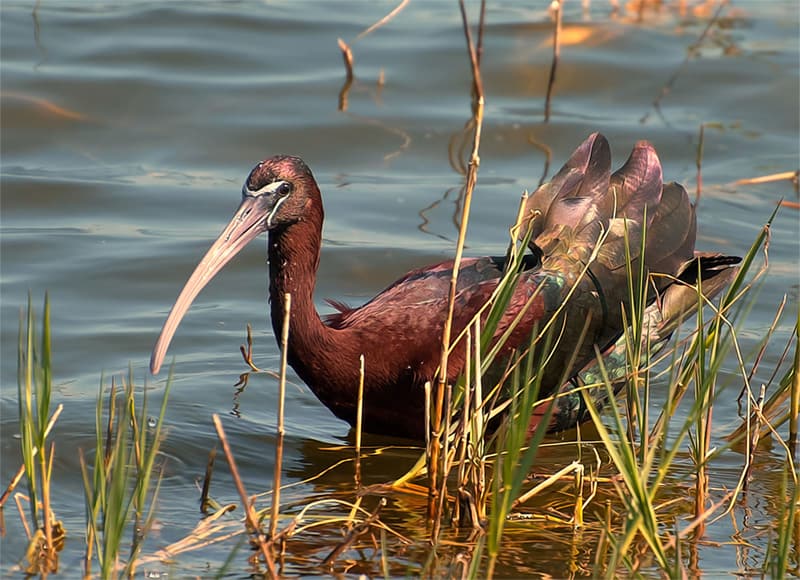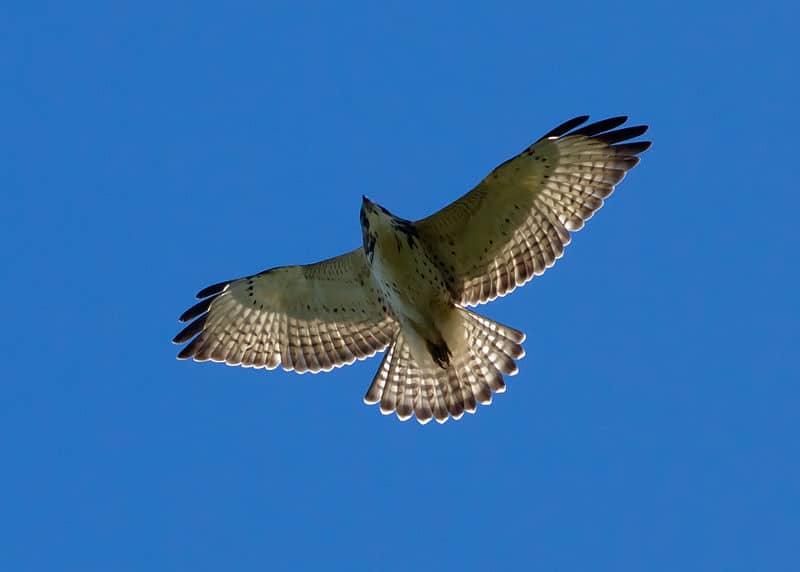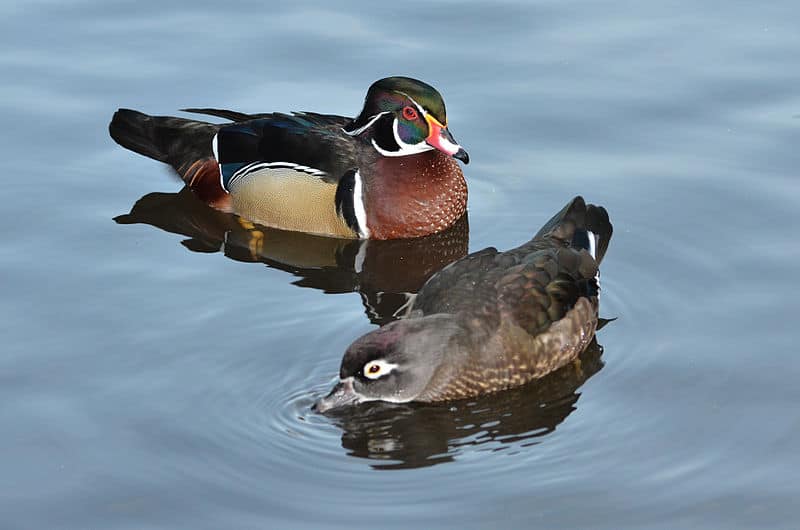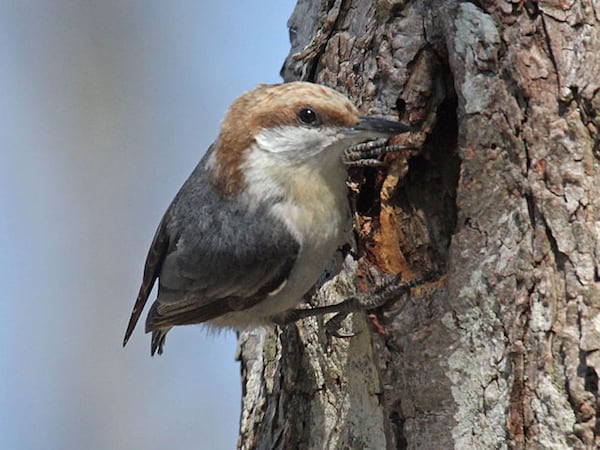1. Glossy Ibis
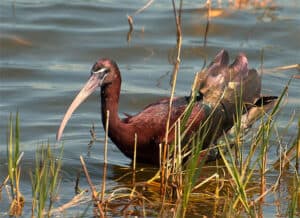
At approximately 23 inches tall, the decurved bill and dark plumage are easy field marks that help distinguish this species from the similarly sized egrets and herons with which it usually associates. Unlike herons, often seen with their necks folded in flight and while resting, ibis keep the neck straight. If viewed in full sunlight, the mature birds show a deep iridescence in shades of green, bronze, or purple. The immatures, as well as the adults during winter, are all dark and sometimes appear to have a slightly “washed-out” color on the head and neck. The glossy ibis can be distinguished from the less common immature white ibis by the all dark head, neck, and breast.
Glossy ibis are common during summer in coastal marshes and wetlands and can occasionally be found during winter along the coast. There are only a few records of transients in the piedmont and mountain regions. This species, a self-introduced alien from Africa, was first recorded in Virginia in 1953, but since then has become increasingly common. The most reliable area to view the birds in Virginia is Chincoteague National Wildlife Refuge.
They tend to congregate in productive feeding areas and wade in shallow water searching for fish or invertebrates. While actively foraging, the lower part of the bill may be submerged. In flight, glossy ibis often form V-shaped flocks, flying with the legs streaming behind and the neck fully extended.
2. Tundra Swan
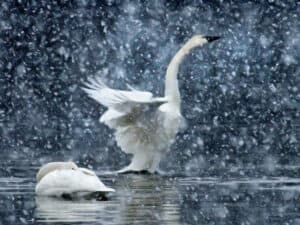
Once called whistling swan, Virginia’s largest native waterfowl the tundra swan is just over 50 inches in length. The long neck, black bill, and white plumage are distinctive. It can be confused only with the mute swan, an Old World species introduced into the United States, that has established feral populations in scattered localities. Mature mute swans have an orange bill, and both matures and immatures usually hold the neck in a slightly curved position. The tundra swan carries the head straight up from the breast. The long neck and uniformly white wings distinguish this species in flight from the smaller snow goose.
During winter tundra swans congregate by the thousands along the coast. Although there are a few summer records, the swan most likely to be seen from June through August is the mute. Tundra swans are rare transients and winter visitors in the piedmont and mountains. The most reliable areas to view the birds in Virginia are Chincoteague and Back Bay National Wildlife Refuges.
The flocks are often heard before they are seen, their loud, high-pitched hoots a common sound over the marshes and bay areas. Although awkward at both take-off and landing, tundra swans are graceful in flight and on the water. They feed in shallow ponds and estuaries, plucking vegetation from the bottom. If the water in which they are foraging is muddy, the head and neck of the birds may appear to be a dingy gray color.
3. Broad-winged Hawk
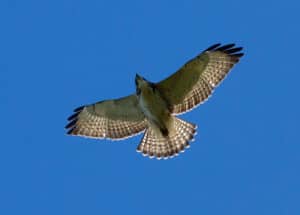
This small woodland hawk has a characteristic round-winged buteo shape and distinctive black and white striped tail. It is about 16 inches in length with a wingspan of just over 30 inches; the back is dark brown and the breast may be a speckled tan or pale color. It is much smaller than the more common red-tailed hawk and the underwings and body are lighter in color than the red-shouldered hawk. The plumage of the immature tends to be variable, but young birds frequently have a dark border along the edge of the underwing.
The broad-winged hawk is an uncommon summer resident in both the piedmont and mountains and is rare on the coastal plain. Nesting in deciduous woodlands, they perch fairly low while hunting and prey on small mammals, reptiles, frogs, and large insects. The call is a shrill whistle, and in courtship birds can be fairly vocal.
Although they are easily overlooked during spring and summer, the autumn migration of the broad-winged hawk is one of nature’s real spectacles. In mid-September the birds gather by the thousands as they move south along the ridgetops toward their wintering grounds in Central and South America. Huge flocks swirl up, riding the thermal drafts, and more than 15,000 birds have been counted in a single day. Some well-known hawk-watching sites in Virginia are Harvey’s Knob at Milepost 95.4 on the Blue Ridge Parkway, Rockfish Gap on Route 250 near Waynesboro, and Snicker’s Gap, 20 miles west of Leesburg on Route 7. These sites are manned from early September through October, and the broad-winged migration peaks from mid through late September.
4. Peregrine Falcon
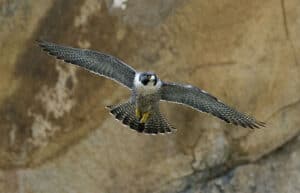
Considered by many to be the most regal of the birds of prey, during Medieval times it was the peregrine falcon that flew from the arm of monarchs. A magnificent “flying machine,” the aerodynamic profile and swept-back wings of the peregrine falcon make identification relatively easy. The crown, face, and neck of the bird are black, with a distinctive white wedge running up the neck to form a characteristic “helmet” over the head. The back and wings are slate gray, the throat is white, and the underparts are streaked. Immature birds are dark brown above and have a more heavily streaked breast and throat.
Historically, the peregrine falcon nested along cliff faces of the Appalachian ridges in Virginia. Never common in the region, widespread use of DDT resulted in its complete extirpation as a breeding bird by the 1960s. It is classified as an endangered species, but reintroduction programs have established nesting sites along the Eastern Shore and its numbers have been increasing throughout eastern North America. Today the birds nest on manmade structures, including towers constructed for their use along the Eastern Shore, tall buildings in urban areas, and bridges. Peregrine falcons prey on birds, particularly rock doves, shorebirds, and waterfowl.
Autumn is the best time of year to see the peregrine falcon as it migrates along the coast. The hawk-watch site at Kiptopeke State Park on the Eastern Shore counted a season total of 490 birds in 2003. The peak count that year was on October 4, when 79 birds were seen.
5. American Oystercatcher

The distinctive, almost garish, appearance of the American oystercatcher leaves no question as to the identification of this species. This large, chunky shorebird is about 18 inches in length. The adult has a dark brown back, black head and neck, and white breast. The thick, long bill is bright red. The legs are dusky pink and the bright golden eye is rimmed in red. In flight, diagonal white wing patches and a white rump are clearly visible.
The American oystercatcher is a common permanent resident along the coastline of the Eastern Shore, more easily found during summer. Although occasionally seen south of Cape Henry, the most reliable area to find the bird in Virginia is at Chincoteague National Wildlife Refuge.
Search for oystercatchers along exposed mudflats where noisy flocks gather to feed on mollusks. Using its bill, the bird will dislodge prey and then pry open the shell. During high tide, when the mudflats tend to be covered by water, look for oystercatchers along the beach at the water’s edge. The nest is a simple scrape in the sand and the parents will become agitated if the eggs or young are approached. The call is a sharp whistle, usually given as the birds take flight.
6. Saw-whet Owl
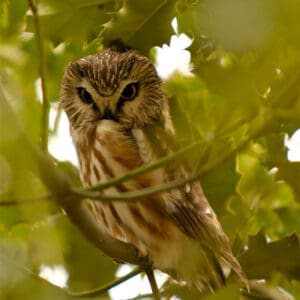
This shy and elusive owl is rare in Virginia and difficult to find. At about 8 inches long, it is smaller than a cardinal, and tends to roost in dense evergreens. The facial disk is round and, unlike the relatively common screech owl, the saw-whet has no ear tufts. The back and wings are rich red-brown and the breast is pale with heavy brown streaking. Immatures tend to be more uniformly rusty brown.
A rare winter visitor on the coastal plain and piedmont, it is a probable breeder at high elevations in the mountains of Virginia. Summer records are from Tazewell, Bath, and Highland Counties and the Mount Rogers area. The sound of the mechanical and repetitive high-pitched calls, from which the species derives its name, are said to resemble the sound of a saw being sharpened or “whetted.” It is relatively silent and unresponsive except on breeding territory, and the secretive nature of the saw-whet owl makes observation difficult.
However, recent studies revealed that although saw-whet owls do not vocally respond to taped calls, they will fly in toward the sound. Banding studies at night using calls to attract the owls into the nets indicate a significant autumn migration through Virginia. Because they are an irruptive species, the number of migrating saw-whet owls tends to vary widely from one year to another. Banding stations currently operate during late October and November on the Eastern Shore, at Lynchburg, and near Harrisonburg. Check the Virginia Society of Ornithology website for current banding schedules. Most banders welcome visitors but prefer to be notified ahead of time. The Lynchburg banding station netted 38 birds in 2003, with a peak count of 8 on November 17.
7. Veery

Much like a washed-out version of a wood thrush, the veery is not particularly distinguished in appearance. About 7 inches long, the back is dull brown and the underparts are white, usually with fine streaks or a buffy cast to the throat. The bill is straight and similar in shape to that of a bluebird. The veery is most often found at or near the ground as it forages over the forest floor in search of insects or grubs.
Except in the mountain region, where it is relatively easy to locate, the veery is uncommon in migration across the state, and can be easily overlooked. The veery breeds at elevations above 3,000 feet in Virginia. This species is well worth finding, not so much for its appearance, but for the beauty of its song, considered by many to be among the most lovely of North American birds. A twisted version of the adage that “it is better to be heard than seen” definitely applies when considering the veery. Early settlers referred to the call of the veery as “fairy-singing,” and a college student once remarked, at hearing the notes for the first time, that it sounded as if a ghost were playing electronic music.
The song is a down-slurred, melodic, flutelike whistle of two tones overlaid on one another. The veery sings most frequently at dusk and dawn. Packing a picnic dinner and heading for Sunset Field at Milepost 78.4 on the Blue Ridge Parkway is a popular activity. As the sun begins to set, the veery chorus provides the most glorious dinner music. These birds can be found during late spring and summer in many deciduous woodlands above 3,000 feet in elevation.
8. Cerulean Warbler
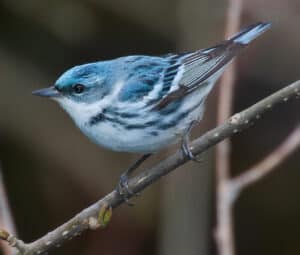
Lacking the fiery iridescence of the indigo bunting or the true tones of the bluebird, the color on the back of the male cerulean warbler is, nevertheless, one of the most beautiful in nature. This is a tiny warbler, just under 5 inches in length, and it prefers to feed high in the canopy, so getting a glimpse of the bird’s back is not easy. The color has been described as the blue-grey of a stormy day washed with the mist of the Great Smokey Mountains. The breast is white with a fine black necklace just under the throat, and the two pale wing bars are key fieldmarks. The females and immatures are more yellow and difficult to distinguish.
Cerulean warblers are rare transients on the coastal plain and local breeders in the piedmont and mountain regions. Autumn is not a good time to search for these birds, as they will be in cryptic fall plumage and identification is about as difficult as decoding a cipher written in a language that you don’t speak. Like many of the neotropical migrants, its numbers have been decreasing in recent years. One of the more reliable areas to find the birds is in the vicinity of the Peaks of Otter on the Blue Ridge Parkway, where they often forage near the top of tall tulip poplar trees. Look for cerulean warblers in late spring and summer.
The easiest way to locate the bird is through hearing the song, a fast series of buzzy notes ending with a sharply up-slurred trill. Once the presence of the cerulean warbler is suspected, scan the canopy for movement. The bird tends to be a fidgety feeder, moving quickly among the leaves to glean insects. Patience is required to get a good view, but persistence will be rewarded by a look at one of creation’s most elegant colors.
9. Rose-breasted Grosbeak
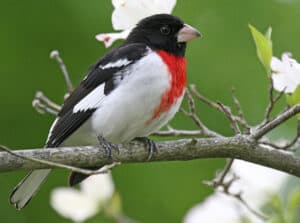
Occasionally in early May a quick look at the bird feeder will reveal the astonishing surprise of a rose-breasted grosbeak feasting on sunflower seeds. About the size of a cardinal, the male has a solid black head and back and the wings are also black with white wing patches near the shoulder. The lower breast and sides are white, but the throat and upper breast are brilliant rose-red. In flight, the rose color can be seen to extend along the underside of the wings. The pale, cone-shaped bill is relatively large. Females and immatures resemble big, streaked, heavy-billed sparrows.
Rose-breasted grosbeaks are fairly uncommon transients on the coastal plain but are relatively common migrants over the piedmont and mountains. They breed at higher elevations across Virginia and are easy to find along much of the Blue Ridge Parkway. In recent years rose-breasted grosbeaks have become increasingly common as visitors to bird feeders during migration.
The song of the rose-breasted grosbeak is reminiscent of a robin that has been to an intensive voice class. The melody is a long, clear, and somewhat complex warble. The call note, a metallic chink, often provides an alert to the bird’s presence. Rose-breasted grosbeaks sing from an exposed perch and their large size and bright colors make them easy to see.
10. Baltimore Oriole
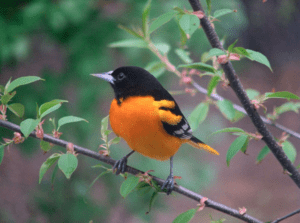
The brilliant orange of this songbird makes it difficult to accept that it is related to the blackbird family. However, like its more drably colored relatives, the bill and body shape help to identify it as member of this diverse group. It is a large bird, nearly nine inches long; the male, with its black head and predominantly orange body, is easy to identify. The female is more uniformly peachy-yellow and can be confused with the smaller female orchard oriole or with the pale-billed female tanagers.
The Baltimore oriole is approaching the southern limit of its breeding range along the east coast and tends to be more widespread in the mountain region of Virginia and toward the northern part of the state. It is a common transient, particularly along the coast during the fall. Occasionally Baltimore orioles will spend the winter in Virginia, and when present during the colder months, will visit bird feeders. Look for the Baltimore oriole in tall hardwoods, especially sycamores, along riverbanks and ponds. Other preferred habitats include parks that have mature deciduous trees and suburban neighborhoods with established plantings.
The pendulous, cup-shaped nest is fairly easy to find because the birds frequently attach the woven structure near the end of a branch. The song is a clear, somewhat piping whistle and the birds tend to be strong singers throughout the day.

